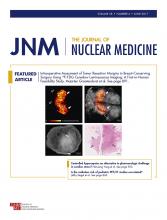Questioning pediatric dose optimization: Siegel and colleagues evaluate evidence refuting the linear no-threshold model and review studies suggesting that children are not more radiosensitive than adults in the radiologic imaging dose range.
Page 865
Liquid biopsy vs. PET: Wong and colleagues look at the advantages and disadvantages of analysis of circulating tumor DNA and circulating tumor cells and compare the resulting capabilities with those of PET for cancer treatment monitoring and surveillance.
Page 869
Molecular imaging of atherothrombosis: Osborn and colleagues highlight current metabolic and molecular imaging clinical and near-clinical applications in atherosclerosis and venous thromboembolism and describe the potential for metabolic and molecular imaging for individualized risk prediction and disease treatment.
Page 871
Endocrine tumor imaging: Taïeb and colleagues provide commentary and perspective on current PET/CT radiopharmaceuticals targeting endocrine-related cancers, including agents with potential to go beyond localization and more accurately characterize endocrine tumors at the molecular level.
Page 878
Rapid imaging of tumor cell death: Neves and colleagues describe the validation of phosphatidylserine-binding agents labeled with a near-infrared fluorophore, 99mTc, or 111In for detection of tumor cell death based on the C2A domain of synaptotagmin-I.
Page 881
64Cu-/177Lu-labeled anti-EGFR antibody: Laffon and colleagues estimate the kinetic parameters of a diagnostic/therapeutic convergence radiopharmaceutical that acts as an anti–epidermal growth factor receptor in mice bearing esophageal squamous cell carcinoma tumors.
Page 888
CLI for assessing breast tumor margins: Grootendorst and colleagues report on the results of a first-in-human study on the feasibility of 18F-FDG Cerenkov luminescence imaging for intraoperative assessment of tumor margins in breast-conserving surgery.
Page 891
Metabolism and tumor size change: Park and colleagues use CT and 18F-FDG PET to evaluate responses in tumor size and metabolism during chemotherapy for advanced gastric cancer and explore the related effects on patient survival.
Page 899
89Zr-bevacizumab PET and everolimus: van Es and colleagues determine whether 89Zr-bevacizumab PET imaging can identify early disease progression after initiation of everolimus treatment in patients with metastatic renal cell carcinoma.
Page 905
18F-FMISO pharmacokinetics in NSCLC: Schwartz and colleagues detail the results of pharmacokinetic analysis of 18F-fluoromisonidazole PET extended to 3 h after injection in patients with stage III–IV non–small cell lung cancer.
Page 911
Parametric methods in 18F-FLT PET/CT: Kramer and colleagues validate parametric methods for quantification of 3′-deoxy-3′-18F-fluorothymidine PET in patients with advanced-stage non–small cell lung carcinoma and an activating epidermal growth factor receptor mutation in treatment with gefitinib or erlotinib.
Page 920
Pretargeted α-therapy: Heskamp and colleagues compare the tumor-targeting properties and therapeutic efficacy of 213Bi and 177Lu for pretargeted radioimmunotherapy of carcinoembryonic antigen–expressing xenografts using the bispecific monoclonal antibody TF2 and the di-HSG-DOTA peptide IMP288.
Page 926
Neurotensin receptor–directed theranostics: Fendler and Baum provide perspective on radioligand therapy using agents with high affinity to target specific cell surface receptors in cancer and preview an article on this topic in this issue of JNM.
Page 934
NTR1 theranostics: Schulz and colleagues explore the therapeutic effect of a 177Lu-labeled analog of neurotensin receptor 1−targeting agent 111In-3BP-227 on tumor growth in NTR1-positive HT29 colon carcinoma xenografts.
Page 936
Semiquantitative PSMA PET imaging: Li and colleagues assess variability in normal-organ uptake of 18F-DCFPyL, a small-molecule inhibitor of the prostate-specific membrane antigen, and describe the implications of these findings for biodistribution studies, image interpretation, and therapeutic monitoring.
Page 942
18F- and 68Ga-labeled PSMA tracers: Dietlein and colleagues evaluate the prostate-specific antigen–stratified performance of the 18F-labeled prostate-specific membrane antigen tracer 18F-DCFPyL and the 68Ga-labeled reference 68Ga-PSMA-HBED-CC in patients with biochemical recurrence of prostate cancer.
Page 947
MBF response to arterial CO2: Yang and colleagues investigate whether a physiologically tolerable hypercapnic stimulus can increase myocardial blood flow to levels observed with adenosine in canines without coronary stenosis, with non–flow-limiting stenosis, and after preadministration of caffeine.
Page 953
Valve localization in cardiac SPECT: Betancur and colleagues describe the development of a machine learning approach to automatic mitral valve plane placement, with a resulting decrease in user dependence on SPECT myocardial perfusion imaging quantification.
Page 961
18F-NaF, 18F-FDG, and plaque progression: Li and colleagues analyze associations between inflammation and osteogenesis at different stages of atherosclerosis, as well as the relationships between these two processes during disease progression.
Page 968
18F-JNJ311 as a tau PET ligand: Declercq and colleagues describe the synthesis of this tracer with high affinity for aggregated tau and high in vitro selectivity for tau over β-amyloid and compare it with 18F-AV1451 in preclinical dynamic PET imaging.
Page 975
Evaluation of σ1 PET tracers: Baum and colleagues report on the first PET imaging evaluation in rhesus monkeys of 4 18F-labeled spirocyclic piperidine-based PET radiotracers.
Page 982
Variability of 123I-CLINDE SPECT: Feng and colleagues examine in healthy individuals the test–retest variability of binding for this radiotracer developed for SPECT targeting of the 18-kDa translocator protein.
Page 989
Comparison of THK PET tracers: Betthauser and colleagues compare the in vivo imaging characteristics of the tau PET ligands 18F-THK-5351 and 18F-THK-5317 in patients with Alzheimer disease or genetic predisposition to neurodegenerative disease.
Page 996
Immuno-PET and GvHD: Van Elssen and colleagues detail the development of a method to noninvasively image immune responses in a relevant humanized mouse model of graft-versus-host disease.
Page 1003
MSOT colitis imaging: Bhutiani and colleagues assess in mice the applicability and utility of multispectral optoacoustic tomography for evaluating the presence and severity of colitis.
Page 1009
- © 2017 by the Society of Nuclear Medicine and Molecular Imaging.







